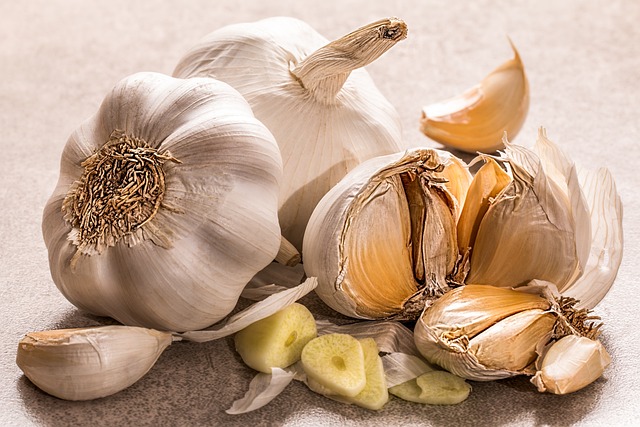Garlic is not just a kitchen staple; it’s also a joy to grow in your garden. Whether you’re a novice gardener or a seasoned green thumb, understanding the garlic growing stages and how to plant garlic properly can ensure a bountiful harvest. In this comprehensive guide, we’ll explore what garlic plants look like, how deep to plant garlic, and the best practices for planting garlic in spring.

What Garlic Plants Look Like
Garlic (Allium sativum) is characterized by its long, slender leaves that shoot up from a bulb buried in the soil. These leaves, known as garlic scapes, have a distinct odour and flavour that are synonymous with culinary dishes worldwide. The plant can vary in height depending on the variety and growing conditions, typically reaching between 1 to 3 feet tall.
During its growth cycle, garlic develops a central stalk that eventually produces a flower head, known as a garlic scape. This scape, if left unharvested, will ultimately form tiny bulbils that can be replanted to grow new garlic plants.
How Deep to Plant Garlic
Proper planting depth is crucial for the successful cultivation of garlic. Garlic cloves should ideally be planted about 2 inches deep into the soil. This depth ensures that the cloves are adequately covered with soil, allowing them to sprout and develop roots easily.
It’s important to space individual cloves approximately 4 to 6 inches apart in rows that are 12 to 18 inches apart. This spacing provides enough room for the garlic bulbs to mature without overcrowding, which can lead to smaller bulbs and potential disease issues.
How to Plant Garlic in Spring
Planting garlic in spring requires careful timing and preparation to ensure optimal growth and development. Follow these step-by-step instructions for planting garlic in your garden this spring:
1. Choose the Right Garlic Varieties:
Select garlic varieties suited to your climate and growing conditions. Softneck garlic varieties are typically best for warmer climates, while hardneck varieties thrive in cooler regions.
2. Prepare the Soil:
Garlic prefers well-draining soil with good fertility. Amend the soil with compost or well-rotted manure to improve its texture and nutrient content. Ensure the soil pH is between 6.0 to 7.5, slightly acidic to neutral.
3. Break Apart Garlic Bulbs:
Before planting, carefully separate garlic bulbs into individual cloves. Use the largest cloves from each bulb, as they will produce the largest bulbs at harvest time.

4. Planting Garlic Cloves:
Dig individual holes or furrows about 2 inches deep. Place each clove pointed end up (the blunt end with the root scars facing down) into the soil. Space cloves 4 to 6 inches apart within rows spaced 12 to 18 inches apart.
5. Cover and Mulch:
Gently cover the cloves with soil, pressing down lightly to ensure good contact with the soil. Apply a layer of mulch, such as straw or chopped leaves, about 2 to 3 inches thick. Mulching helps retain soil moisture, suppresses weeds, and protects the garlic cloves during winter in colder climates.
6. Watering and Care:
Water newly planted garlic thoroughly after planting and continue to keep the soil evenly moist throughout the growing season. Garlic requires approximately 1 inch of water per week through rainfall or irrigation.
7. Fertilization:
Apply a balanced fertilizer or compost tea once or twice during the growing season to provide additional nutrients. Avoid high-nitrogen fertilizers, as they can encourage excessive leaf growth at the expense of bulb development.
8. Harvesting Garlic:
Garlic is typically ready for harvest in late spring to early summer, depending on the variety and local growing conditions. Watch for the lower leaves to turn yellow and begin to dry out. Carefully dig up the bulbs using a garden fork, being careful not to damage them.
9. Curing and Storing Garlic:
After harvesting, allow the garlic bulbs to cure in a dry, well-ventilated area for 2 to 4 weeks. Once the outer skins are dry and papery, trim the roots and tops, leaving about 1 inch of stem attached. Store cured garlic bulbs in a cool, dry place with good air circulation.

Conclusion
Growing garlic can be a rewarding experience for gardeners of all skill levels. By understanding the garlic growing stages, knowing what garlic plants look like, planting garlic at the correct depth, and following proper techniques for spring planting, you can enjoy a plentiful harvest of fresh, flavorful garlic. Whether you’re planning a small backyard garden or a larger plot, the satisfaction of growing your garlic is unmatched. Follow these guidelines and tips to grow garlic successfully and enjoy its culinary benefits year-round. Happy gardening!
Garlic Plant- Learn How To Identify and Grow Garlic At Your Home!

